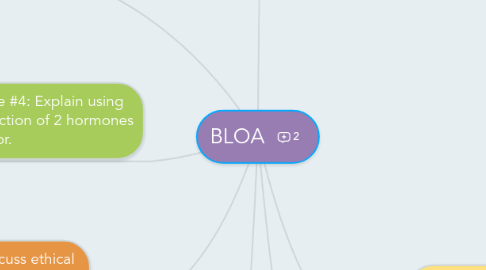
1. Learning Outcome #2: Discuss ethical considerations in research into genetic influences on behavior
1.1. Humans
1.1.1. All ethical considerations are applicable.
1.2. Animals
1.2.1. All ethical considerations are common except for their protection from harm, informed consent, and deception
1.3. Study Example: Mermot et al (1997), Milner (1996), and Newecomer et al.
2. Learning Outcome #3: Explain using one or more examples, the effects of neurotransmission on human behavior.
2.1. Acetylcholine
2.1.1. Facilitates learning and memory. Deficiency disrupts learning and memory.
2.1.1.1. Study Example: Martinez & Kesner (1991)
2.2. Norepinephrine
2.2.1. Too little may lead to depression. Too much causes hyperactivity.
2.3. Dopamine
2.3.1. Too much may lead to schizophrenic reaction. Too little may cause Parkinson's.
2.4. Serotonin
2.4.1. Lack of serotonin produces anemia. Prevents dreaming in the waking state. Considered as the "worry chemical" in the brain.
2.5. GABA
2.5.1. Decreases the level of the neuron. May decrease the levels of anxiety
2.6. Endorphins
2.6.1. A neuropeptide that acts like a pain reliever
3. Learning Outcome #4: Explain using examples, the function of 2 hormones on human behavior.
3.1. Oxytocin: It is known as the "love hormone" that is usually associated with a mother-daughter bond. It is also a neurotransmitter that travel along the nerve cells in the brain and is released with touches and hugs.
3.1.1. Effect on human behavior: Oxytocin increases our emotions of happiness, empathy, trust and bonding between two individuals.
3.1.1.1. Study Example: Couple studies by Lights (University of North Carolina)
3.2. Cortisol: It is known as the "stress hormone"
3.2.1. Arousal, stress hormone, memory
4. Learning Outcome #5: Discuss two effects on the environment of the physiological process
4.1. Effect #1: Sports and technology
4.1.1. Study Example:
4.2. Effect #2: Meditation
5. Learning Outcome #1: Outline principles that define the biological levels of analysis
5.1. Nervous and endocrine systems
5.2. Genetics
5.3. Animal Research
5.4. Study Example: Brunner's study of 1993
6. Learning Outcome #6: With reference to relevant research studies discuss the extent to which genetic inheritance influences human behavior
6.1. Intelligence
6.1.1. Bouchard and McGue (1981)-closer
6.1.2. Minnesota Twin Study (Bouchard et al 1990)-longitudinal
6.1.3. Hainer et al (1988)
6.1.4. Plomin and Petrill (1997)
6.2. Behavior and Genetics
6.2.1. Concordance and Heredity
6.2.1.1. Thomas Bouchard’s concordance study of identical twins (1979)
7. Learning Outcome #7:Discuss the use of brain-imaging technologies in investigating the relationship between biological factors and behavior.
7.1. EEG: Electroencephalogram
7.1.1. Strengths vs Weakness Strength: Used for sleep studies Brain activity changes in specific ways during sleep Not sufficiently accurate because electrodes are outside the skull Detect uncountable neurons hence give vague picture Not sufficient to understand localization of brain
7.2. CT: Computed tomography
7.2.1. Strength: Can see the brain from several angles & depth Extremely useful to see structure of the brain Can show changes caused by brain damage Weaknesses Can show only structure not brain activity Danger of exposure to x-ray radiation
